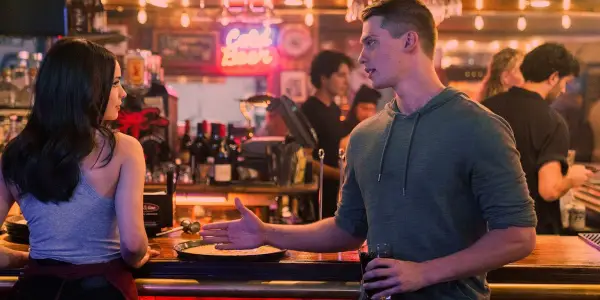For the romance genre, many times, success is in the presentation and triumph of incompatibility. A common thread through each film that leans into this narrative structure, many prove to the melting hearts of their audience that opposites truly do attract and that unions of the heart go beyond expectation. For Elizabeth Allen Rosenbaum, her film Purple Hearts is no exception, bringing two unlikely souls together in a fight for life and love.
Yet, Purple Hearts attempts to elevate itself beyond the traditional “opposites attract” romance, interweaving contemporary social criticism on the challenges of the modern world. And while it does not always land or break the standard convention, Purple Hearts proves that the challenges of attraction go beyond just the individuals at hand.
Big Pharma
Purple Hearts opens with a slow and brief introduction of our central duo, their surroundings, and their environment drawing audiences into contrasting worlds. From a bar to a military boot camp, there is a sense of carefree and regimented worlds that begin to shape both Cassie (Sofia Carson) and Luke (Nicholas Galitzine). Yet, where the film maintains a formulaic romance throughout, giving little deviation in structure, it’s the idea of two worlds merging that truly elevates the film.

As viewers watch the unlikely duo unite, it is their individual motivations that truly united two separate lives. For Cassie, viewers learn early on that she is suffering from Type 1 Diabetes, a disease that not only helps to propel the film’s romance but its criticism of Big Pharma. As Purple Hearts visually structures the various jobs Cassie takes on to make it by, we quickly learn it is not enough as she is left to choose between paying for the various medications that are literally keeping her alive and her rent.
Just weeks after the film’s release, Senate Republicans voted a resounding “no” to legislation that would have capped the price of insulin at $35 dollars, effectively preventing those suffering from Diabetes from affordable healthcare. As the price of insulin skyrockets, Cassie’s struggle hits deeply and feels lived in, her pockets empty. with nowhere to turn and no one to help. There is an urgency Purple Hearts is able to craft in her need, one that Carson harnesses well both in desperation and endurance.
Addiction and Independency
Yet as Cassie struggles to literally survive in a society seemingly designed to drive her to poverty and death, Purple Hearts takes a moment to recognize that it is not just Big Pharma’s stronghold on the drug industry that has devastating effects. On the other end, illegal drugs bring devastation all their own. For Luke, a past history of drug use and loan sharking becomes his own motivation to consider the fraudulent marriage Cassie has proposed. For Luke, his past decisions ripple out from himself, their effects threatening to engulf all those around him.
And in the face of addiction and recovery, he finds himself in the same situation as Cassie, out of options, with no one to turn to. Where the social criticism of Purple Hearts gives light to both struggles, it uses them as a means to motivate the narrative, infusing not only the heightened “what if we get caught” feeling (that the romance formula stipulates will happen), but also giving the means to motivate the romance. Because after all the drama and the musical numbers, that is what we are here for.
Conclusion:
As each of their struggles has hardened both Cassie and Luke to strict independence, it is these struggles that truly make their romance possible. Purple Hearts is wholly aware of this from the moment the film begins and embraces it through undeniably captivating cinematography and an evenly paced story that effectively brings the film to its final moments.
Yet, where the film finds its successes, it also finds its own struggles. Purple Hearts leans heavily into the music career of Cassie, giving it a memorable soundtrack for those who fall in love with the film but also feeling at times like a filler. The film also asks viewers to suspend their sense of belief, moments that seem just a bit too much requiring viewers to just “go with it”. And while this critique alone can be generalized as a trope of the genre, it weighs down its social criticism losing some of the authenticity it has worked so hard to craft.
Purple Hearts stands as a viable romance venture that is sure to pull at your heartstrings while delivering a platform of conversation for the modern struggles its central romance derives from.
Have you seen Purple Hearts? What did you think? Let us know in the comments below!
Purple Hearts is now playing on Netflix!
Watch Purple Hearts
Does content like this matter to you?
Become a Member and support film journalism. Unlock access to all of Film Inquiry`s great articles. Join a community of like-minded readers who are passionate about cinema - get access to our private members Network, give back to independent filmmakers, and more.